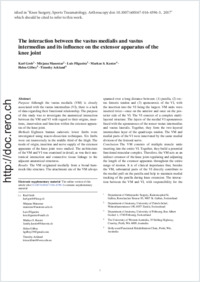The interaction between the vastus medialis and vastus intermedius and its influence on the extensor apparatus of the knee joint
- Grob, Karl Department of Orthopaedic SurgeryKantonsspital St. Gallen, Switzerland
- Manestar, Mirjana Department of AnatomyUniversity of Zürich-Irchel, Switzerland
- Filgueira, Luis Department of AnatomyUniversity of Fribourg, Switzerland
- Kuster, Markus S. The University of Western AustraliaCrawley, Perth, Australia
- Gilbey, Helen Hollywood Functional Rehabilitation Clinic, Perth, Australia
- Ackland, Timothy The University of Western AustraliaCrawley, Perth, Australia
-
25.01.2017
Published in:
- Knee Surgery, Sports Traumatology, Arthroscopy. - 2017, p. 1–12
English
Although the vastus medialis (VM) is closely associated with the vastus intermedius (VI), there is a lack of data regarding their functional relationship. The purpose of this study was to investigate the anatomical interaction between the VM and VI with regard to their origins, insertions, innervation and function within the extensor apparatus of the knee joint.Methods: Eighteen human cadaveric lower limbs were investigated using macro-dissection techniques. Six limbs were cut transversely in the middle third of the thigh. The mode of origin, insertion and nerve supply of the extensor apparatus of the knee joint were studied. The architecture of the VM and VI was examined in detail, as was their anatomical interaction and connective tissue linkage to the adjacent anatomical structures.Results: The VM originated medially from a broad hammock-like structure. The attachment site of the VM always spanned over a long distance between: (1) patella, (2) rectus femoris tendon and (3) aponeurosis of the VI, with the insertion into the VI being the largest. VM units were inserted twice—once on the anterior and once on the posterior side of the VI. The VI consists of a complex multi- layered structure. The layers of the medial VI aponeurosis fused with the aponeuroses of the tensor vastus intermedius and vastus lateralis. Together, they form the two- layered intermediate layer of the quadriceps tendon. The VM and medial parts of the VI were innervated by the same medial division of the femoral nerve.Conclusion: The VM consists of multiple muscle units inserting into the entire VI. Together, they build a potential functional muscular complex. Therefore, the VM acts as an indirect extensor of the knee joint regulating and adjusting the length of the extensor apparatus throughout the entire range of motion. It is of clinical importance that, besides the VM, substantial parts of the VI directly contribute to the medial pull on the patella and help to maintain medial tracking of the patella during knee extension. The interaction between the VM and VI, with responsibility for the extension of the knee joint and influence on the patellofemoral function, leads readily to an understanding of common clinical problems found at the knee joint as it attempts to meet contradictory demands for both mobility and stability. Surgery or trauma in the anteromedial aspect of the quadriceps muscle group might alter a delicate interplay between the VM and VI. This would affect the extensor apparatus as a whole.
- Faculty
- Faculté des sciences et de médecine
- Department
- Département de Médecine
- Language
-
- English
- Classification
- Biological sciences
- License
-
License undefined
- Identifiers
-
- RERO DOC 280234
- DOI 10.1007/s00167-016-4396-3
- Persistent URL
- https://folia.unifr.ch/unifr/documents/305258
Statistics
Document views: 134
File downloads:
- pdf: 835
